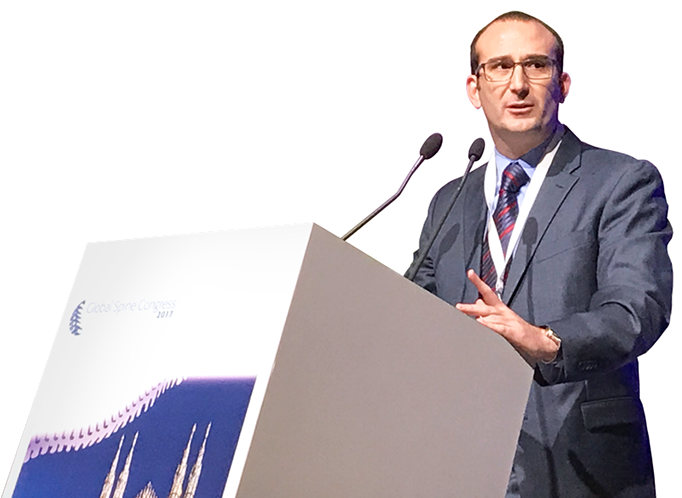feature stories
A class act—Interview with Alexander Vaccaro
Meet the AOSpine Chairperson-elect Shanmuganathan Rajasekaran
Highlights
Davos Courses 2017
Social media—friend or foe? How to manage your online reputation
A new virtual library for AOSpine Members (Spanish/Portuguese)
Educating globally—a quick guide for cross-cultural communication
Crossing borders—International Educator of the Year 2016 Juan Emmerich
Success story: regional courses in Mexico
INSIGHTS Spine is Growing Fast
AOSpine members opinion matter!



Juan Emmerich gives about 100 lectures per year, many of them to an international audience. In this short interview, he shares insights about the challenges of teaching internationally, and why he believes that every young surgeon should become a member of AOSpine.
What do you most enjoy about educating people?
I believe in setting an example. Every time I teach I put a lot of time and passion into it and I try to encourage the students to be the best of their possibilities.
I am professing the first-year medical students. I most enjoy teaching young medical students because they truly believe that they can change the world, and you can see the passion in their eyes. All of this is a huge motivation for me.
"With young surgeons, it's also essential what happens after the lecture, when they come and ask you for advice."
With young surgeons, it's also essential what happens after the lecture, when they come and ask you for advice, such as where they can go for a fellowship, or for a meeting recommendation.
What do you teach mostly and how much of your time do you spend educating others?
I teach mostly spinal surgery and anatomy. I probably give around 100 lectures per year and spend one-third of my time on teaching activities. I spend around 70 days per year traveling outside of my work, and I go to 20–25 meetings a year for education and task forces.
You delivered a fascinating seminar about cross-cultural education at the Global Spine Congress. What is your recommendation for international educators?
"Stay humble, especially in countries that you don’t know and be respectful of the cultural and political differences."Teaching in different cultural environments is always challenging. I recommend being humble, not only because it’s polite but because the first day you believe that you are better than the others you make a huge mistake.
How is spine education changing in Latin America? Can you share your experiences?
We are traveling the world less to attend a lecture, but we do have to be in contact with people worldwide to learn from their skills.
Thus, to acquire new skills, the traditional lecture-based meetings are going to disappear, and we are moving to a more fluid, digital classroom where you receive all the necessary information in advance.
You celebrate ten years of AOSpine membership this year. What does being part of the organization mean to you?
I joined AOSpine in 2007 as a young faculty assistant at Universidad Nacional de La Plata in Argentina. It was an incredible experience for me because it was all brand "For me, being part of AOSpine has been a life-changing experience."new; I didn’t have the background of AO Trauma that other people had so that was my first contact with the organization. After that, I was more involved year after year.
Why would you recommend young surgeons to become a member of AOSpine?
Especially for people from Latin America, the Middle East, and the Asia Pacific region, it is a unique opportunity to be part of a real worldwide organization and to change things by becoming the international champion of a task force or joining a regional or national board. I am 41 years old, and the average age of people on these programs is very young. Young people always look to make an impact, and this is a unique opportunity to do so at a national, regional and international level.
Crossing borders International Educator of the Year 2016
Juan Emmerich
Newsletter 13 October 2017
Feature stories
A class act—Interview with Alexander Vaccaro
Meet the AOSpine Chairperson-elect Shanmuganathan Rajasekaran
Highlights
Davos Courses 2017
Social media—friend or foe? How to manage your online reputation
A new virtual library for AOSpine Members (Spanish/Portuguese)
Educating globally—a quick guide for cross-cultural communication
Crossing borders—International Educator of the Year 2016 Juan Emmerich
Success story: regional courses in Mexico
INSIGHTS Spine is Growing Fast
AOSpine members opinion matter!